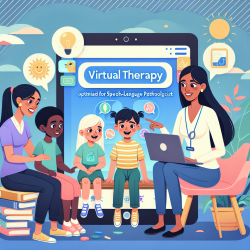Introduction
In an era where technology is rapidly advancing, the field of audiology is no exception. The study "Remote self-report and speech-in-noise measures predict clinical audiometric thresholds" highlights the potential of remote audiometric tools to revolutionize hearing care. As a practitioner, understanding and implementing these tools can enhance your practice and provide better care for your patients.
The Need for Remote Audiometric Tools
The World Health Organization estimates a significant increase in individuals with disabling hearing loss by 2050. Traditional in-person audiological services are struggling to meet this growing demand, especially in low- and middle-income countries where resources are limited. The COVID-19 pandemic has further underscored the necessity for remote, reliable hearing assessments.
Key Findings from the Study
The study investigated the reliability of remote, self-administered digits-in-noise (remote-DIN) tests compared to lab-based tests. The results were promising:
- High internal consistency of remote-DIN tests, correlating significantly with lab-DIN tests.
- No significant mean difference between remote and lab tests.
- Remote-DIN tests effectively predicted pure-tone audiometry results, with the 2-kHz filtered test explaining 50% of variance.
Additionally, the Speech, Spatial, and Qualities of Hearing (SSQ-12) self-report tool also showed significant predictive validity for audiometric thresholds.
Implementing Remote Audiometric Tools in Practice
As a practitioner, integrating these remote tools can significantly enhance your service delivery. Here’s how you can start:
- Adopt Remote Testing: Utilize remote-DIN tests to offer reliable hearing assessments outside the clinic. This is particularly beneficial for patients in remote areas or those with mobility challenges.
- Incorporate Self-Report Tools: Use tools like SSQ-12 to gain insights into patients' hearing experiences in real-life situations. This can help tailor interventions more effectively.
- Stay Informed: Keep abreast of the latest research and technological advancements in tele-audiology to continuously improve your practice.
Encouraging Further Research
While the study provides a strong foundation, further research is encouraged to explore the full potential of these tools. Consider collaborating with researchers or conducting your own studies to contribute to the growing body of knowledge in tele-audiology.
Conclusion
Remote audiometric tools are not just a response to current challenges but a step towards a more accessible and efficient future in hearing care. By embracing these innovations, practitioners can provide high-quality care to a broader population, ensuring no one is left behind.
To read the original research paper, please follow this link: Remote self-report and speech-in-noise measures predict clinical audiometric thresholds.










